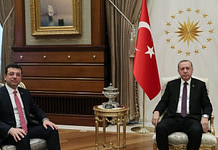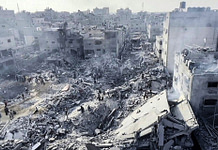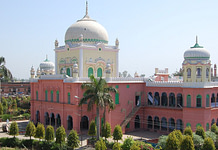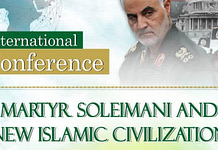Translated by Diego Traversa, revised by Benedetta Scardovi-Mounier
Georgia from Jason to Gamsakhurdia
Georgia was part of the same State of Russia until 1991 when it has risen as independent nation from the ashes of the Soviet Union. In origin, in this western Caucasian area there were different countries, the most important of which was the Kingdom of Colchis, looking on the Black Sea and also well known by the ancient Greeks: according to mythology, it was there that Jason and the Argonauts got the Golden Fleece with the help by the native princess Medea.
Instead, the most mountainous part of eastern and southern Georgia belonged to the Kingdom of Kartli (known by Greeks and Romans as “Iberia”).
These two kingdoms were forerunners in adopting Christianity as their official religion already at the beginning of the fourth century. After being conquered by Rome in 66 a.C. and ruled first by the Romans and then by the Byzantines for almost half a millennium, present Georgia used to be a battlefield during the wars between Byzantines and Persians: this situation had a share in the political disintegration of the country that, in the seventh century, became an easy prey to the Arab expansion. In the eleventh century, the country managed to get rid of the Arab rule and, for the first time, it was united under a single Kingdom of Georgia that began to expand all over the Caucasian area while fighting off the Seljuk Turks.
Yet, in the thirteenth century Georgia surrendered too quickly before the relentless advance of the Mongols and it started to break down into many little states, some of which were later annexed to the Ottoman Empire, while some others to the Persian one.
It wasn’t until 1762 that part of the country became independent again: the eastern one, reunited under Erekle II as Kingdom of Kartli-Kakheti.
In 1783 this kingdom concluded the Treaty of Georgiev’sk with the Russian Empire, thus becoming a protectorate of Russia, whose Tsar was acknowledged as the legitimate ruler over eastern Georgia (to which, however, autonomy over internal policies was still granted).
On December 22nd 1800, at the demand of the Georgian king George XII himself, Tsar Paul I declared the annexation of the Kingdom of Kartli-Kakheti to Russia.
Despite the local aristocracy, who was hostile to the annexation, in summer 1805 the Russian army turned out to be decisive in driving back a Persian attack (the battle at the Askerani river). Five years later, the troops of Tsar Alexander I also incorporated to Russia the western part of Georgia, which at the time formed the Kingdom of Imereti.
During the following decades, the Russians waged many wars against the Turks and the Persians, expanding the borders of Georgia remarkably through the conquest of Azarija, of the towns of Lomse and Poti, and of Abkhatia.
After the Russian Revolution of 1917, with the social-democratic Bolsheviks coming into power, many regions already belonging to the Empire—ruled by the Mensheviks—declared their independence: Finland, the Baltic states, Belarus, Ukraine and the transcaucasian countries, let alone the several and momentary political formations created by the “whites”, the tsarist counterrevolutionaries.
Only few of these declarations were grounded on a mass patriotic spirit that in some case wasn’t even rooted amongst the local ruling classes: this is proven by the fact that, after the February Revolution, the body of the former Russian Empire remained untouched.
What made it blow up and break to pieces was the violent seizure of power by the Bolsheviks who occupied the capital Petrograd on November 1917 and at the beginning of 1918 dissolved by force the newly-elected constituent assembly, since their representatives were by far outnumbered within it.
It was then that those political forces themselves, now ousted from power in Russia, took their revenge against the Bolsheviks by proclaiming the independence of the peripheral regions they themselves controlled.
Of these separatist momentary governments, the Georgian one is considered to be as the most stable and effective in its administrative role, even though the “Democratic republic of Georgia” actually was no more than a protectorate of Britain (which had taken military action as anti-Bolshevik force, just as the other powers from the Entente did). During its brief existence, the Menshevik Georgian government stood out also because of its aggressiveness: first it was at war with Armenia over some ethnically mixed territories, then it attacked the White Army of Moiseev and Denikin so as to expand Georgia’s borders towards Sochi (nowadays a renowned Russian resort on the Black Sea). This did nothing but weaken it in sight of the final showdown with the Bolsheviks who, in the meantime, had successfully brought to an end the civil war and who had undertaken the task of winning back the separatist regions: on February 1921, the Red Army entered Georgia and suppressed the Menshevik and pro-British republic within few days, incorporating the country into the dawning USSR (first as part of the Transcaucasia and then, in 1936, as federate socialist soviet republic).
When the Bolsheviks’ leader and President of Russia Vladimir Ilic Ulianov (better known as Lenin) died after a long weakening disease, it was a Georgian who succeeded him: Iosif Vissarionovic Dzugasvili from Tblisi, who has gone down in history as Stalin, the man who held the reins of Russia for over 30 years.
Half a century later, the amazing but short-lived history of the Soviet Union came to an end. Georgia declared its independence on the 9th of April 1991 and its first President (appointed in 1990 when the country was still USSR-federate) was Zviad Gamsakhurdia, former leading dissident in the communist era.
The independence proclaimed through the “Georgia to Georgians” slogan couldn’t but concern the several ethnic minorities living around the administrative entity of Tblisi which Gamsakhurdia and his nationalistic supporters wrongly regarded as being a monolithic national bloc. Namely, the regions of Azarija and Abkhazia (that were annexed to Georgia by the Russians who had taken them away from the Turks), as well as South Ossetia (whose inhabitants are alike those from the Russian province of North Ossetia) claimed the same right to independence from Russia Tblisi itself wanted (and put into practice). Already in 1989, South Ossetia, autonomous province of the socialist soviet republic of Georgia, was scene to violent fights between the Ossetians, loyal to Moscow, and nationalistic Georgians.
The Ossetian regional council came to declaring secession from the Socialist Soviet Republic of Georgia but this one reacted by lifting Ossetia’s autonomy status, thus prompting further fights.
Newly-born Georgia’s internecine clashes weren’t inter-ethnic only but also political: on January 6th 1992 Gamsakhurdia-led government was overthrown by a bloody coup d’etat that was anything but quick since it was started two weeks before.
Gamsakhurdia found shelter in Chechnya (after a brief stay in Armenia), under the rebel government of General Dzochar Musaevic Dudaev. The coup leaders proclaimed Eduard Shevarnedze as new president, former Soviet Foreign Minister at the time of Gorbacev. The fights between the new President’s supporters and the partisans of the removed one went on for two years. On September 1993, then, an outright war burst between the Georgian army and the Abkhazians who refuse still today to be subdued to Tblisi’s authority since they are the majority in the north-western part of the country. There were dreadful fights and the Abkhazians came off successful since they fought off Tblisi’s troops and drove out some thousand Georgians living in Abkhazia. Gamsakhurdia snapped up the chance and, already on late September 1993, he returned to his homeland, leading his armed followers in an revolt attempt. The rebellion seemed likely to be successful but Shevarnadze, by approving to let Georgia join the Independent States Community, received the support by the neighbour countries, not least Russia which provided him with men and weapons: within November the rebels were defeated and on the following month their leader Gamsakhurdia died under circumstances that were never completely cleared up.
Meanwhile, the long time of disorders and internecine fights cost a high price to the newly-born Georgian republic: alongside with Abkhazia, also South Ossetia managed to achieve the independence: oddly enough, many Chechnyan separatists have fought for the freedom of the former, whereas the Russian aid was decisive for the latter.
The “Rose Revolution”: Saakashvili President of Georgia
President Shevarnadze, during the following decade, got two acknowledgments from the people, by winning the elections on 1995 and 2000. The elections held on November 2nd 2003, that were allegedly rigged according to the pro-US media and organizations, embodied the fuse for a new political violent reshuffle, the so-called “Rose Revolution”. Shevarnadze has often repeated that those who wanted and led that coup were the US; and, needless to say, the deposed Georgian President can’t be suspected of anti-Americanism. For example, suffice it to remind that, in the capacity of Russian Foreign Minister, during a meeting with the American President of that time, George H. W. Bush, he asked him for an advice about what kind of foreign policy Russia was to maintain, since he wanted to refrain from pursuing any ambition of defence of the national stakes. Yet, as President of Georgia, Shevarnadze proved to be too independent and, above all, too prone to keep good relations with Moscow.
It was probably because of this that the US hatched one of the most successful “coloured revolutions”, bringing back to power a racist and strongly anti-Russian nationalistic leader: the new Gamsakhurdia is called Michail Saakavshili, a jurist who was trained at the American universities.
Saakashvili served as Minister of Justice under Shevarnadze’s government, well-known for its repressing character (partly accounted for by the Gamsakhurdian insurrection and by the fight against separatist tendencies). As President, albeit the incessant emphasis on “democracy”, Saakashvili has not proven any better in respecting his people’s civil rights: appointed by “Bulgarian” percentages (96% of votes in 2004), he has often accused his rivals of being criminals or Russian spies, treating them accordingly.
After seizing power, Saakashvili has purged the Georgian leadership through mass arrests both of former ministers of Shevarnadze’s government (that is to say his former peers, in controversy with which he had stepped down) and of simple local administration representatives. In 2004, a group of Georgian intellectuals wrote an open letter to denounce the intolerance against political opponents.
An emblematic case of the dreary situation and of the rampant violence in Saakashvili’s Georgia was the murder of Sandro Girgvliani. He was a 28 year old bank manager and on the night between 27th and 28th of January 2006, in a Tblisi’s bar, he had a quarrel with some high officers from the Interior Ministry, who were there to celebrate the birthday of one of them, Inspector General Vasil Sanodze.
Girgvliani and his friend Levan Buchaidze, after leaving the bar, were shoved into a Mercedes and brought to the outskirts of the town: Buchaidze managed to escape but Girgvliani was beaten to death and his body was found the following morning.
The investigation from the “Imedi” tv station managed to shed light upon the case, denouncing the Interior Ministry’s responsibilities. The alleged murderers were arrested and sentenced seven to eight years, yet whoever gave the order has still gone unpunished: in spite of the popular protests, all of the high officers from the Ministry retained their charge. Badri Patarkatsisvili, owner of the “Imedi” station that not only reported the authorities’ responsibilities in Girgviliani affair but also other similar cases, underwent several fiscal investigations and political pressures so that he would be induced to curb his journalists’ autonomy.
Irakli Okruasvili, former Georgian Defence Minister, accused his former ally Saakashvili of wanting to attempt the life of Patarkatsisvili himself who, meanwhile, entered politics as the rival of the President: two days later, Okruasvili was arrested with the charge of corruption and money laundering, and only after having disavowed the accusations against Saakashvili he was released. Expelled to France, where he got asylum, on November 5th 2007 he appeared on “Imedi” tv where he confirmed the authenticity of the accusation against Saakashvili while accounting for the disavowing due to the forced imprisonment. Few months later, he was convicted with final judgment by the Georgian magistracy, the same one which abstained from investigating over the alleged murderous will of Saakashvili against Patarkatsisvili. Incidentally, on 12th February 2008 Badri Patarkatsisvili was found dead in his British residence, few hours after having a meeting with Boris Berezovskij, Russian “oligarch” and Putin’s implacable enemy. The Georgian businessman, who was only 50 years old and had never suffered of heart problems during his lifetime, died from heart attack. The local police classified his case as “suspicious”.
Saakashvili has regularly adopted the iron fist against any opposition. During the second half of 2007, the government reacted by putting down the demonstrations sponsored by his political adversaries: on November 7th, after repeated attacks from the police, a group of protesters decided to resist the institutional violence and thus the fights took place. Saakashvili quickly exploited the pretext in order to proclaim the state of emergency for nearly ten days while imposing, amongst other things, the censure on the national media.
Yet, the mass protests forced Saakashvili to step down and face, on January 2008, a new electoral test: he won, notwithstanding the strong criticism both from the OCSE (generally much acquiescent towards US-sponsored candidates) and from the opposition, which denounced systematic fixing and manipulated opinion polls.
Mikhail Saakasvili has never forgotten the crucial support from the US for his violent seizure of power. During his mandates, he has always been a staunch ally to them, emerging also for his nationalism liable to rash actions and for his visceral Russia-phobia, that is after all widely shared by his fellow countrymen. Georgia entering the NATO is Saakasvili’s main target and he has dispatched a hefty amount of troops following the US all over the main theatres of war and occupation: Iraq, Afghanistan and Kosovo. Yet, even if the Georgian troops garrison Kosovo so as to assure the freedom to the local ethnic minorities to separate from Serbia, Saakasvili has never recognized that very right to “his” independence-craving minorities: Azarija, Abkhazia and South Ossetia. Indeed, “making up the national unity” has always been one of the cornerstones of his political agenda. Azarija, unlike the other two regions, never waged war against Georgia so as to achieve that independence it formally didn’t claim either: yet, during the storming Shevarnadze’s era, it got independent de facto. Back to early 2004, just appointed President through the “Rose Revolution” coup, threatening to use military force, Saakasvili forced Azarija to submit to Tblisi’s authority, depriving it, among other things, of its traditional autonomy. In Batumi, the capital of Azarija, there was the 12th Russian Naval base, one of the last soviet structures inherited by Moscow outside its own national territory. After many months of tensions, Tblisi and Moscow came to an agreement and the Russians handed over the base in November 2007, one year sooner than expected. The Russian Federation didn’t oppose much resistance in defending Azarija nor its Batumi’s base, being too far from its own territory and being of no strategic importance.
Things went differently when Saakashvili, perked up by the first success, tried to repeat the deed with South Ossetia.
This region, that the local population calls Chussar Iryston (Juznaja Osetija in Russian), is directly adjoining with Russian Federation and namely with an ethnically kindred province: North Ossetia republic. Although the Ossetians, who descend from the Alans, are a very different ethnic people from the Russians— the former being Indo-Iranian, and the latter Slavic—during the post-soviet era have been Moscow’s staunch allies in the northern Caucasian area. In the early 90’s, while the South Ossetians bloodily fought the Georgians so as not to be subdued to the newly-born Georgia, the Northern ones coped with the Ingushetians who were predominant in the district of Prigorodnij and politically very close to the Chechnyan rebels. The Ingushetians were mostly kicked out from the district that was repopulated with South Ossetian refugees escaping the Georgians’ violent actions.
The rivalry between Ossetians and Islamist terrorists, yet, has never soothed, as was tragically proved by the massacre of Ossetian kids carried out by the Chechnyan rebels of Samil Basaev in Beslan in 2004.
When Saakashvili became President, South Ossetia was living in peace for about a decade: in 1992 Tblisi, Moscow and Tskhinvali (South Ossetia ’s capital) agreed upon a ceasefire, setting up in the area a mixed peacekeeping force made up of Georgians, Russians and Ossetians.
In 2004, after having subdued Azarija, Saakashvili made the tension mount again with South Ossetia: yet, for years the clash has never gone beyond a “creeping” and “dirty” war made up of kidnappings, dynamite attacks and occasional fire exchanges between the opposite militias.
The outburst of the conflict
In the summer of 2008, Georgia marked a quantum leap in its war activism. If it has up to now limited itself to fostering occasional border clashes and leading a strongly anti-Russian diplomacy (suffice it to remind the strict alliance with Ukraine of Jushenko and Timoshenko, the attempts to join the NATO, the building of BTC pipeline conceived in order to leave Russia out of the Caspian Sea source trade), in recent times Tblisi has multiplied its provocations with the clear aim to bring about a war. It is hard to imagine which plans Saakashvili and his staff have had in the past and which ones they will have in the future: maybe to overcome the political internal crisis by directing people against an external enemy, thus making them gather closer to their President; maybe they hoped to seize Abkhazia and Ossetia through blitzkriegs without enabling Moscow to counteract; maybe the aim was and really is that of embroiling Moscow in a new Caucasian war so as to both wear out its military apparatus and to dim its international image with the aid of the propaganda juggernaut handled by the US.
What’s obvious, knowing the strict alliance existing between Tblisi and Washington, is that the US must have played some fundamental role in the crisis bursting out: to say the least, they took no step to prevent Saakashvili from setting off this war. Yet, let’s stick precisely to the chronology of facts.
To avoid having to go back to older incidents and disputes, a reasonable starting point can be fixed at the 20th of April of this year when, according to the Georgian authorities, one of their drones (a remote-controlled aircraft, part of a lot purchased from a private Israeli company, with the green light of the Israeli Defence ministry) was shot down in Abkhazia’s airspace by Russian crafts. Consequently Tblisi demanded a compensation from Moscow which, instead, denied the fact. The tension in the area was already high since Georgia had started massing troops on the border with the breakaway region, namely in the disputed area of Kodori gorge.
On May 29th a car bomb blasted in Tskhinvali during the independence celebrations, injuring six passers-by: the Ossetian President pinned the blame for the attack on the Georgian government. On May 31st three hundred Russian unarmed soldiers entered Abkhazia at the local government’s demand, in order to help build a railway system: at the same time, Moscow increased the amount of peacekeeping troops in the province—as a reply to the Georgian mobilization—but without exceeding the maximum number fixed by the agreement (that’s 3,000 soldiers): this induced Georgians to cry out against the “occupation of Abkhazia”, supported by the EU that calls for the Russians to withdraw the additional troops.
On June 17th on the Ossetian border the Georgian troops arrested four peacekeeping Russian soldiers accused of smuggling weapons: they are released after a nine-hour third degree.
In the meantime, drones start flying again over Abkhazia, even if Tblisi denies. On the following day, two blasts took place along a railway at Suchumi, Abkhazia’s capital: the target, according to the investigators, were the Russian troops deployed there. On June 29th two new dynamite attempts occurred, this time at the Abkhazian coast town of Gagrij: six are injured. Two days later, a blast at the Suchumi’s market mowed down further civilians. The repeated attacks lead the Abkhazian authorities to shut the border with Georgia that is regarded as being responsible for the terrorist attacks. On July 4th, during the night, the Ossetian capital Tskhinvali (at the border with Georgia) was briefly bombed by the Georgian artillery (at least 15 mortars, according to the witnesses): 3 persons lost their lives and 11 are wounded. The incident was confirmed both by the Russian peacekeeping forces and by the OSCE envoys, yet the Georgians gave no account; Moscow’s reply defined the fact as “an act of open aggression”, and a few days later it begun manoeuvres in the northern Caucasus. The Abkhazian President Sergej Begaps claimed he has laid his hands, thanks to his secret services, on an invading plan of Abkhazia by Georgia which, meanwhile, has massed twelve thousand soldiers at the borders, 2 thousand of which only at the Kodori gorge.
On July 7th, a new bomb shocked Abkhazia again: four people injured by a blast in a café and the local authorities have no doubt in holding the Georgian security forces as responsible. The following day also South Ossetia protested against Saakashvili’s expansionistic aspirations: the proof is claimed to be the evacuation started by Tblisi of some thousand Georgians living in South Ossetia. On July 9th it was Georgia’s turn to denouncing an attack at one of its outposts along the border with Abkhazia, an operation carried out by about ten armed men but with no casualties. Oddly enough, the same day the Abkhazians claimed they have suffered an identical attack at one of their outposts.
The focus of the fighting, in the first half of July, seemed to be directed more towards Abkhazia than North Ossetia, and the Abkhazian President Sergej Bagaps rushed to Moscow to ask the Russian aid; there he met also with the South Ossetian colleague Eduard Kokojty. Meanwhile, the American Secretary of State Condoleeza Rice arrived in Tblisi: Washington’s envoy expresses full support to Tblisi’s warlike policy while warning Moscow from trying to defend the freedom of Abkhazians and Ossetians. On July 10th Georgia called back its own Moscow-based ambassador due, officially, to “the outrage over the aggressive Russian policy”. Sergej Lavrov, Russian Foreign Minister, tried to restore the dialogue while demanding, yet, the precondition of the Georgian evacuation of troops deployed in fighting trim at Kodori gorge; Tblisi’s reply is a litany of the same old anti-Russia rhetoric, the accuse of an alleged “aggression” by Moscow and the closing to any mediation (Abkhazia and Ossetia are outspokenly defined, leaving no room to negotiations, “inalienable parts of Georgia”). The Georgians oppose a clear refusal to Lavrov’s offer to hold talks in Moscow, preferring to use July for joined military manoeuvres with American, Azerbajian and Ukrainian troops and to get a Presidential decree approved by the Parliament to increase of 5,000 units the number of recruits, thus raising Tblisi’s armed forces to 37,000 soldiers.
On July 16th, the 76th Russian airborne division arrived in northern Caucasus, officially to take part to the military manoeuvres that in all involve 8,000 men, 700 fighting vehicles and 30 crafts. While President Saakashvili turned down the idea about a Moscow-sponsored non-aggression agreement with Georgia and Abkhazia, it was Suchumi to refuse the mediation plan proposed by the Germans which is considered as questioning of Abkhazia’s independence status. The following week there was a succession of new incidents between Georgia (always active) and South Ossetia: four Ossetians arrested by the Georgian police; the infringement of the Ossetian space by Georgian air forces; finally, on July 29th, Georgian troops opened fire over two Ossetian villages.
The night between August 1st and 2nd some fire exchanges came about along the Georgia-South Ossetia border, with at least 6 dead and 15 wounded amongst the Ossetians and 10 casualties amongst the Georgians (but the Ossetians claim 29 dead Georgian soldiers): it was the beginning of the present war, even if on August 7th a formal truce is proclaimed by both the fronts. Yet, few hours later, the Georgian would break it in order to launch their own attack.
Before analyzing carefully the details of the conflict, let’s look at the set of facts schematically reported so far and which embody the prelude to war, as a whole. What we can detect is the obvious concentration of Georgian troops at the borders with Abkhazia and Ossetia, accompanied by continuous provocations that range from the warlike rhetoric to mortar shells and outright terrorist attacks (the bombs in Abkhazia the local authorities charge Tblisi with).
On the other hand, the reaction is the mobilization of the breakaway forces in both the regions, as well as the massing of Russian troops both in northern and southern Caucasus.
At this point, we have to go back to the hypothesis made at the beginning of the paragraph as regards the Georgian leadership’s hidden aims. If Tblisi’s plan were that of seizing Abkhazia and Ossetia through quick and sudden attacks, thus forestalling the Russian reactions, then we should draw the conclusion that all this has been arranged and carried out in the worst possible way: the even too obvious preparations and the continuous provocations couldn’t but alert the enemies who, as a matter of fact, were poised to fight off the Georgian offensive as soon as it was eventually set off. The way of approaching to the conflict makes us think of other hypothesises as well.
For instance, Tblisi might have tried to provoke the Russians pushing them into carrying out the attack as first in order, then, to play the victim and to win international support. Actually, this hasn’t completely turned out well since the Georgians had to launch the first attack and only thanks to the huge and effective US-managed propaganda machine they have succeeded in slanting the American and western European public opinions to their own advantage. At any rate, what’s left is the problem whether NATO’s diplomacy can really force the Russians to evacuate Abkahzia and South Ossetia , leaving them at Tblisi’s mercy. This possibility looks extremely remote, if one takes into account that Moscow enjoys the right of veto within the UN Security Council. Economic pressures might be more effective, yet it’s hard to think that Moscow will approve of a settlement that be detrimental over the status quo ante of a conflict it is definitely winning.
One can also suppose that Tblisi has overrated (at least in view of the aforementioned considerations) its own military power, thinking of maybe being able to overwhelm the Abkhazian, Ossetian and Russian defences; or, at least, of being able to drive the Russians to trespass its territory and to face them there through guerrilla warfare. But in this case we should draw the conclusion that Mr Saakashvili is pursuing stakes diverging from the ones of the country which he’s called to answer to.
Anyway, the impression is that the Georgians have lost control over the situation. It’s likely that they didn’t expect such a massive and resolute reaction by Moscow and that they set too many hopes in the effectiveness of its own military machine and in a more incisive and quick intervention by the Atlanticist diplomacy (and maybe also in greater military support).
The war
On early August several shootings took place along the border between Georgia and South Ossetia while Russian volunteers begun flocking into the separatist region. After some days of preparations, with mortar shells over Tskhinvali and the surrounding villages, the night between August 7th and 8th the Georgian troops launched the offensive against the South-Ossetian capital. Tskhinvali, on the extreme southern limit of Ossetia, is located only five kilometres (ca. 3 miles ) from the Georgian border, along the main road of the region that, from the Georgian town of Gori, crosses South Ossetia and leads to Rokskij tunnel that can be considered the sole junction with the Russian Federation. The attack against the Ossetian capital was carried out with infantry and armour while the Georgian Su-25 jet aircrafts dropped bombs over Kvernet village (and even over a humanitarian convoy, according to the Ossetians).
The Georgian advance immediately penetrated as far as 10 kilometres (6.2 miles) the Ossetian inland along three fronts: South Ossetia’s eastern border, Tskhinvali’s corridor in the south and a salient in the west for what looks like a pincer movement.
Yet, the offensive stopped at the Ossetian capital: the breakaway troops resisted starting violent fights from house to house during which Tskhinvali suffered many damages and civilian casualties (some thousands): it’s worth reminding that most of the South Ossetian inhabitants have Russian citizenship. The South Ossetian Parliament and a couple of the Russian peacekeeping forces’ barracks were also blown up: about ten Russian soldiers were killed and the Russian Premier Vladimir Putin, from Beijing, announced a response.
The reaction is immediate: while Russian aircrafts started bombing Gori, the first big centre on the way to Tskhinvali (30 kilometres is the distance between the two cities), the units from the 58th army (comprising about one hundred tanks and heavy artillery) entered South Ossetia: on the following day, also President Medvedev officially announced the Russian counteroffensive.
On August 9th the Georgian troops are fought off from Tskhinvali that, yet, has suffered huge material damages and human losses, notwithstanding the brevity of fights.
Some of the 35 thousand Ossetian refugees who have fled to Russia reported atrocities carried out by the Georgians: snipers willfully opening fire on the helpless, entire villages set ablaze, bombings on civilian targets, tanks willfully running over children. Those testimonies made Putin and Medvedev state that they were dealing with the attempt on the part of the Georgians to carry out a genocide against the Ossetians.
In the meantime, the Russian counteroffensive got wider: airborne troops were parachuted near Tskhinvali, thus raising to 10,000 the number of effectives in the operation while the air force started hammering new targets, mostly Poti, a harbour town on the Black Sea from which Georgia is thought to get Ukrainian military supplies.
The Russian airforce losses were said to amount to four crafts, although the Georgians claim to have shot down twenty of them. American planes brought back to Georgia the contingent of 2,000 men Tblisi sent to Iraq. On August 10th, a part of the Russian fleet in the Black Sea, including the Moskvà cruiser, after setting sail from Sebastopolis base, got to the border with Georgian territorial waters (only a Georgian rocket-launching patrol boat tries to react but it will be sunk); at the same time, the Russian bombings has reached Kodori gorge, favouring an offensive by the Abkhatian militias against the Georgian troops massed there with threatening purposes. On August 12th, after setting South Ossetia free from Georgian soldiers (many of which are reported as having given in to the Russians), Moscow announced the end of its counteroffensive, yet reserving the right to intervene again in case of further Georgian attacks against the separatist region. These are the words pronounced by Medvedev: “The operation’s targets have been accomplished: the peacekeeping forces and the civilians are now safe. The aggressor has been punished and has suffered heavy losses as well”.
As things stand, it’s impossible to foresee whether the truce will last or not. The most probable hypothesis is that the ceasefire might actually be respected—Russia has fulfilled its targets while Georgia doesn’t mean to draw out a conflict in which it’s hard put—even if, as the recent history of the region teaches us, it will be dotted with tensions, incidents, provocations, under conditions still marked by instability. It can’t be forgotten, actually, that Abkhazia and Ossetia, in spite of having got the de facto independence status, have been recognized as nations by none of the world countries, not even by Russia. Yet, Georgia and Russia already accuse one another of having broken the truce, while Moscow is sticking to the hardliner tack: the Foreign Minister Lavrov has ruled out any negotiation whatsoever with Saakashvili and even the return to the status quo ante since he considers unsustainable to let Georgian troops, albeit peacekeeping ones, enter South Ossetia again after the aggression carried out against both Ossetian civilians and Russian colleagues in the previous days.
Awaiting to know what is bound to happen, we can draw a partial conclusion over this short conflict—or over this first part of a longer conflict.
In doing so, we are required to take into account both the military factors and the strategic importance of the events and the diplomatic context.
On the eve of the war, the Georgian armed forces could count on over 30 thousand men, two third of which organized in the army. The tanks at Tblisi’s disposal were about two hundreds, all of them Soviet Union-made: forty T-55 and one hundred sixty five T-72. The T-55 is a mid-size tank (35,4 tons, 203 mm as maximum armour, a 100mm cannon), is considered as being the most successful model in the history of tanks, being it still used in 65 countries although its birth dates back to sixty years ago which indeed represents its huge limit.
The T-72 is the more modern type yet it dates back to 1972. It’s heavier (45 tons) than the T-55, better armoured (250mm) and more equipped with fire power (125mm cannon), it’s faster and more provided with fuel distance. Whatever the conditions, the fact is that only one Russian motorized infantry division would have been sufficient to stand up to the entire Georgian army.
That’s why Tblisi should have planned the attack against South Ossetia as a blitzkrieg: to occupy immediately Tskhinvali—capital and sole big city of the province—and the main road leading to Russia, while possibly reaching and making not practicable Rokskij tunnel before Moscow’s reaction.
Mission not accomplished, since even before the Russian intervention, the Ossetian forces alone have been sufficient to restrain the Georgian advance. It’s taken the Georgians a preliminary bombing with BM-21 “Grad” (a Russian-made rocket launcher dating back to the 60’s, still used due to its effectiveness) and two following waves of foot soldiers and armour to penetrate into Tskhinvali, and yet the Ossetian capital has been able to resist until the Russian aid showed up. The D-30 howitzers, the 100mm cannon “Rapir” anti-tanks and, above all, the less advanced remote-controlled 9M113 “Konkurs” rockets provided to the Ossetian militia turned out to be sufficient so that the several obsolete Georgian tanks would turn into wrecked vehicles decorating the streets of a town half destroyed by the violent preliminary bombing.
After all, the “Konkurs”, although they were projected in the 60’s and they began being used in 1974, were successfully used also by Hezbollah militia to stand up to the Israeli “Merkava” tanks.
The Georgian air force is insignificant and indeed it played nearly no role in the conflict: only five Su-25 (Soviet land-covering crafts whose production started in 1981) and fifteen L-29 and L-39 (Czech jet fighters respectively made in the 60’s and 70’s only for pilot training). Too little even to overcome the South Ossetian anti-aircrafts defence. What’s more, the Georgian troops aren’t renowned at all for their training, in spite of their (official) American and (private) Israeli instructors’ efforts and, indeed, there are considered worse than their Ossetian rivals.
Hence the Georgians are thought to have attempted a lightning attack, yet running into the Ossetian resistance and, above all, a surprisingly swift reaction by the Russians who, within few hours, have sent their armour and paratroopers near Tskhinvali and started heavily bombing Georgia’s strategic targets and troop massing. In this respect, the too obvious preparations by the Georgians and their continuous provocations against Ossetians, Abkhazians and Russians turned out to be a big mistake. The only fact that can account for the behaviour of the Georgian political and military staff is that they probably hoped to push the enemy to attack first. Even if this hasn’t happened, the political aim has been partly achieved: the American ally, setting off its propagandistic machine and allied diplomacies, has managed to spread the Russia-aggressor/Georgia-victim pattern; even if the Georgian initiative hasn’t gone unobserved to anyone and the European diplomatic milieu has defined Moscow’s reaction as “disproportionate” (the same expression used in 2006 to mildly blame the Israeli invasion of Lebanon). Nonetheless, Russia ’s veto right within the UN Security Council has spared Moscow serious backlashes. In consideration of the facts, for the moment the Georgian “diplomatic victory” seems to be just in its preliminary stages. Yet, it has been important for them to involve Russia as an active and belligerent part in the dispute over the two separatist regions, thus undermining its peacemaking role it has played up to now. Not surprisingly, the EU has immediately welcomed the idea according to which Moscow won’t be any longer allowed to act as mediator in the Caucasus but, on the contrary, it will have to resort to Brussels’ mediation in its clash with Tblisi. Hence it will be up to Moscow and its resoluteness to ward off the possible diplomatic backlashes of the conflict: Russia is historically a master in winning wars on the ground and then losing them at the negotiation table.
Going back to the strictly military point, what’s left is the fact that the Russians have kicked the Georgian troops out of South Ossetia and have actually bombed Georgia’s military or military-related infrastructures. The merely military targets seems therefore to have been achieved with a surprising rapidity and with little losses (the official report speaks, at the moment, of 18 dead and 152 wounded): the Georgian attack has been fought back beyond the starting-point (Tblisi has lost its contingent stationed in South Ossetia and, seemingly, even the northern part of the Kodori gorge) and the Georgian resiliency for another attack has been seriously undermined, maybe even foiled for months or years to come.
The Russian armed forces has demonstrated to be very fast in the decision-making process at its highest ranks and in reacting at its lowest ones; the only negative aspect is the high losses suffered by the air force: considered the poorness of the enemy, four crafts are undoubtedly too many, even if the undisputed control of air has been achieved quite immediately. Moreover, the Russian counteroffensive has brought some political advantages to Moscow , though a small deferment in closing the operations might have optimized them.
First of all, Saakashvili has been destabilized. The Georgian can look at the Russian aggressor pattern as much as they want (since they consider South Ossetia as being part of the Georgian territory, so the Russian one has been a violation of their sovereignty) but they surely don’t ignore that the Russian alleged “aggression” could have been avoided if their President hadn’t taken such venturesome decisions. Therefore Saakashvili will have to bear responsibility for having set off a conflict they have ruinously lost, even if he will try to politically optimize the “victim” aura.
Secondly, the US’ prestige—and secondly EU’s one —has endured remarkable backlashes in the region. Today facts have showed how much the balance of military power in the Caucasus leans undoubtedly towards Moscow. Washington has been able to counter the Russian offensive with propaganda, with fulminating declarations, with word-only solidarity, and it’s likely to do it also with hefty donations for the rebuilding of Georgian infrastructures; yet the US hasn’t even been able to send a single soldier to protect the supposedly “aggressed” Georgian ally, and Moscow has brought the operation to an end only after having accomplished its own targets. The rash closing of the operations by Moscow will certainly be exploited by Washington and Tblisi in order to make it look like it depended on American pressures aiming at preserving the White House’s prestige in the region.
Moscow’s third success lies in putting off Georgia’s admission to the NATO. If Georgia had been a NATO member, today Europe and the US should have either engaged in the third world war or lost their face before the whole world. Reason for which Georgia’s entrance in the NATO has always been dependent on settling the Abkhazian and Ossetian problems. Now more than ever these problems are serious and their possible consequences obvious. Paradoxically, the only way for Tblisi to enter the NATO, at the moment, would seem to be the annexation of Abkhazia and Ossetia to the Russian Federation: as the saying goes, “off goes the tooth, off goes the ache”. Maybe that’s why Moscow will go on lingering, putting off the settlement of both issues until doomsday.
Source: http://www.eurasia-rivista.org/cogit_content/articoli/EkElZuFVFyJfqfxDct.shtml
Original article published on Aug. 14, 2008
Diego Traversa is a collaborator of Tlaxcala and Benedetta Scardovi-Mounier is a member of Tlaxcala, the network of translators for linguistic diversity. This translation may be reprinted as long as the content remains unaltered, and the source, author, translator and reviser are cited.
URL of this article on Tlaxcala: http://www.tlaxcala.es/pp.asp?reference=5975&lg=en
Questo articolo è coperto da ©Copyright, per cui ne è vietata la riproduzione parziale o integrale. Per maggiori informazioni sull'informativa in relazione al diritto d'autore del sito visita Questa pagina.




















